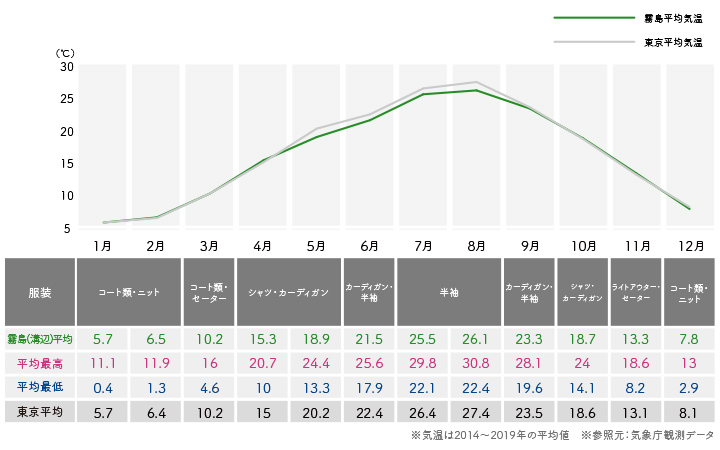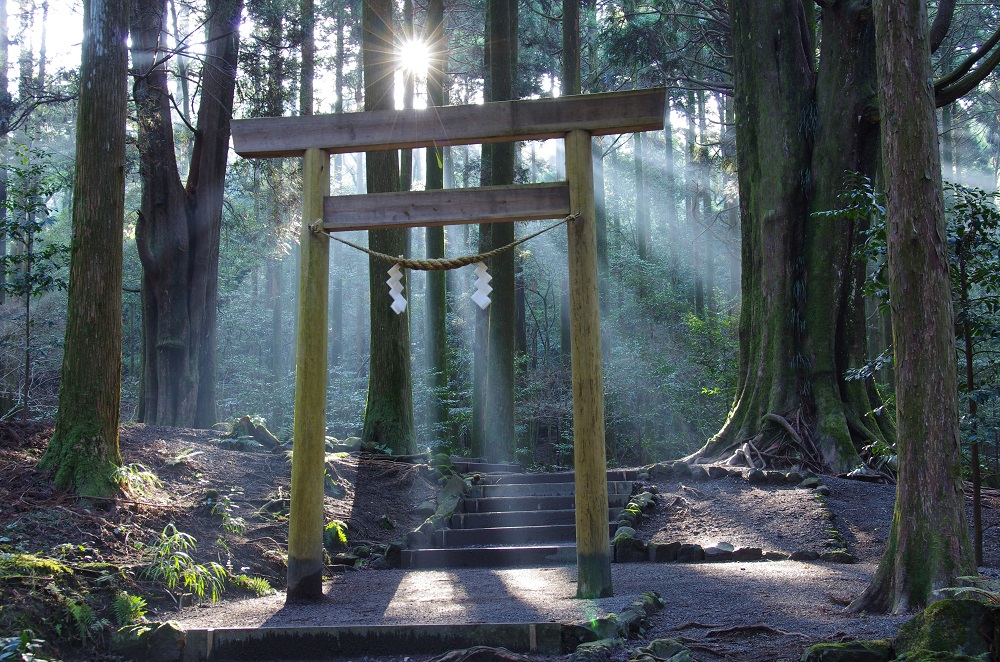Learn about the climate and clothing in Kirishima City, Kagoshima Prefecture, where myths and legends come to life

Kirishima City in Kagoshima Prefecture is the land where the myth of the descent of the grandson of the heavens, which appears in the Kojiki and Nihon Shoki, is passed down, and is also known as the honeymoon destination of Sakamoto Ryoma. The volcanic Kirishima Mountains are in the north of the city, and Kinko Bay spreads out in the south, with Sakurajima spewing smoke. Both are located within Kirishima-Kinkowan National Park, and the city is dotted with historical spots such as Takachiho-no-mine, where it is said the gods descended from the heavens to earth, and Kirishima Shrine, which is said to have been founded in the 6th century.
It is also famous as one of Kagoshima's leading hot spring areas, with four popular hot hot spring including Hinatayama hot spring, which was often visited by Saigo Takamori. The climate is warm throughout the year, but it is known for having some of the highest rainfall in the country, so if you visit during the rainy season or the long rainy season in autumn, it is important to take measures to protect your feet from the rain. It is also one of the most humid places in the country in summer, and the city is humid and hot, but the Kirishima Plateau, at an altitude of 500m, has a comfortable climate with an average temperature of 25°C. The temperature difference between morning and evening is large around the Kirishima Mountains, so be sure to bring an extra layer of cold weather clothing for each season.
▼Kirishima City's annual temperature and clothing

<Kirishima City's climate and recommended clothing>
Kirishima City: Spring (March to May) Weather and Clothing

In early March, the weather continues to change between three cold days and four warm days, with the minimum temperature reaching 2°C and the maximum temperature reaching 20°C. In the latter half of the month, when the average maximum temperature exceeds 15°C, the cherry blossoms begin to bloom. In early April, the cherry blossoms at ancient temples such as Kirishima Shrine and in parks are in full bloom. Knitwear and cardigans are sufficient for cherry blossom viewing during the day, but the temperature drops sharply at night, so be sure to bring a coat.
After the summer mountain climbing season opens in mid-April, the Kirishima Mountains are decorated with flowers. The best time to see the Nokaido, a member of the Malus genus of the Rosaceae family that grows only on the Ebino Plateau, is from mid-April to mid-May. In late April, the yellow flowers of the Rhododendron Hikage bloom on Mt. Ebino, and from mid-May onwards, mountains over 1,500m, such as Takachiho-no-mine, are dyed in the deep pink of the Miyamakirishi. You can also see the delicate sight of spring lindens at your feet. The temperature is around 19°C during this time of year, when many hikers come to see the cherry blossoms. Keep in mind that at high altitudes the temperature drops by 0.6°C for every 100m, so choose your clothing accordingly.
Kirishima City's summer (June to August) weather and clothing

The rainy season usually starts from late May to early June. It is common for the amount of precipitation to be heavy and for the rain to continue for about a week. The average temperature during the rainy season is about 23°C. However, it can still get chilly during the rainy season, so you will want to bring a thin jacket. If you are going on a hike or mountain climbing in high altitudes, choose clothes that are windproof and have cold-weather protection.
The average temperature in July and August is about 26°C. It is 1-2°C lower than the summer in Tokyo, but the humidity is about 5% higher. In late July, when the rainy season ends, the humid heat that is unique to Kagoshima begins, so it is best to wear clothes that allow air to circulate. A must-visit in the hot summer is the "Forest Therapy Road" built around Kirishima Shinsuikyo and Kirishima Plateau, which are located at an altitude of 500m to 700m. You can enjoy forest bathing while feeling the refreshing breeze. "Kokubu Camp Beach" on the north shore of Kinko Bay, which offers a panoramic view of Sakurajima, is also very popular. We also recommend cooling your body from the inside with the famous ice candy "Polar Bear".
Kirishima City Autumn (September to November) Weather and Clothing
.jpg)
Kirishima is packed with autumn events. Starting with the Kirishima City Fireworks Festival in late September, there is the Kagoshima Shrine warrior procession, the Kirishima Hayato Hamaguri in mid-October, the Kirishima Shrine Tenson Korin Goshinkasai on November 10th, and the Niiname-sai on November 23rd. There are also many religious ceremonies at historic shrines, so it is recommended to combine your visit with a tour of power spots.
While it is still hot in early September, the average temperature from mid-September to October is around 20°C, so you can comfortably spend the time in shirts and cardigans. There are also many sunny days, making it a great time to go out. The autumn leaves begin to change color in late October. There are many famous spots, such as Oonaminoike, the crater lake of Mount Kirishima, where the surrounding mountains are dyed in a colorful hues, and Ebino Kogen, where silver grass fields spread out. In November, when the autumn leaves are at their best, the average minimum temperature drops to about 8°C, so it is best to wear warm clothes such as a coat and a scarf when going out to see the autumn leaves.
Kirishima City's Winter (December to February) Weather and Clothing

Kagoshima Prefecture has an image of being warm even in winter, but Kirishima City, where the Kirishima Mountains stand, often experiences days when the minimum temperature drops below freezing. The Kirishima Mountains are usually completely covered in snow and frost in December, when the average minimum temperature is about 3°C. A thick coat will keep you warm while walking around town, but in high altitudes you should protect yourself from the cold with snow boots and down coats. The coldest months are January and February, when the new year is celebrated with the "Tenson Korin Kirishima Kumen Taiko" performance at Kirishima Shrine. The average temperature drops to around 6°C.
Kirishima is famous for its hot spring, and many people visit the four major hot spring at the foot of the Kirishima mountain range to enjoy a tour of hot spring, each with different spring qualities and health benefits. In late February, the yellow witch hazel flowers begin to bloom around Onamiike Pond after the snow melts, signaling the arrival of spring. The temperature difference is still large, with the maximum temperature still above 10°C and the minimum below freezing, so be sure to dress warmly and protect yourself from the cold.






